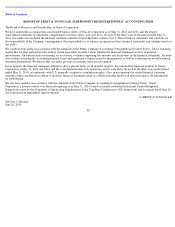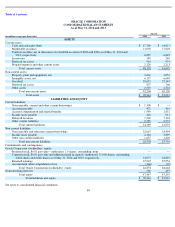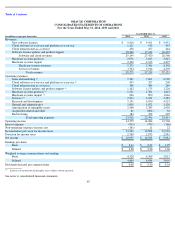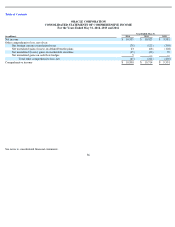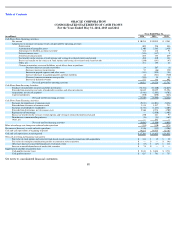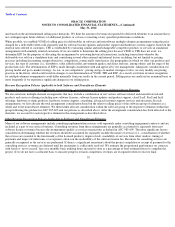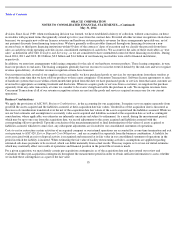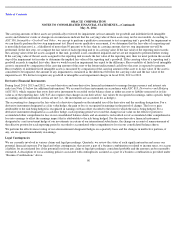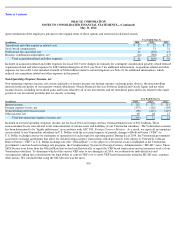Oracle 2013 Annual Report Download - page 96
Download and view the complete annual report
Please find page 96 of the 2013 Oracle annual report below. You can navigate through the pages in the report by either clicking on the pages listed below, or by using the keyword search tool below to find specific information within the annual report.
Table of Contents
ORACLE CORPORATION
NOTES TO CONSOLIDATED FINANCIAL STATEMENTS—(Continued)
May 31, 2014
satisfied. Our cloud IaaS offerings also include our Oracle Engineered Systems hardware and related support that are deployed on-
premise in our
customers’ data centers for a monthly fee and provide for the purchase of additional capacity on demand. Our revenue recognition policy for
these on-premise offerings is in accordance with ASC 605 and ASC 840, Leases , and substantially all of these offerings are accounted for as
operating leases as our contracts are structured so that the term of the arrangement is less than 75% of the economic life of the equipment and the
present value of the minimum fixed payments are less than 90% of the fair market value of the equipment at the inception of the arrangement.
Our evaluation of useful life is based on our historical product development cycles and our historical customer hardware upgrade cycles.
Capacity on demand is a contingent payment and is therefore excluded from our assessment of the net present value of fixed payments. Revenue
for capacity on demand is recognized in the period our customers access additional capacity provided all other revenue recognition criteria have
been met.
Revenues from the sale of hardware systems products represent amounts earned primarily from the sale of computer servers, storage, and
networking products, including the sales of our Oracle Engineered Systems.
Our hardware systems support offerings generally provide customers with software updates for the software components that are essential to the
functionality of our server and storage products and can also include product repairs, maintenance services and technical support services.
Hardware systems support contracts are generally priced as a percentage of the net hardware systems products fees. Hardware systems support
contracts are entered into at the customer’s option and are recognized ratably over the contractual term of the arrangements, which are typically
one year.
Revenue Recognition for Multiple-Element Arrangements—Cloud SaaS, PaaS and IaaS Offerings, Hardware Systems Products, Hardware
Systems Support and Related Services (Nonsoftware Arrangements)
We enter into arrangements with customers that purchase both nonsoftware related products and services from us at the same time, or within
close proximity of one another (referred to as nonsoftware multiple-element arrangements). Each element within a nonsoftware multiple-
element
arrangement is accounted for as a separate unit of accounting provided the following criteria are met: the delivered products or services have
value to the customer on a standalone basis; and for an arrangement that includes a general right of return relative to the delivered products or
services, delivery or performance of the undelivered product or service is considered probable and is substantially controlled by us. We consider
a deliverable to have standalone value if the product or service is sold separately by us or another vendor or could be resold by the customer.
Further, our revenue arrangements generally do not include a general right of return relative to the delivered products. Where the aforementioned
criteria for a separate unit of accounting are not met, the deliverable is combined with the undelivered element(s) and treated as a single unit of
accounting for the purposes of allocation of the arrangement consideration and revenue recognition. For those units of accounting that include
more than one deliverable but are treated as a single unit of accounting, we generally recognize revenues over the delivery period or in the case
of our cloud offerings, generally over the estimated customer relationship period. For the purposes of revenue classification of the elements that
are accounted for as a single unit of accounting, we allocate revenue to the respective revenue line items within our consolidated statements of
operations based on a rational and consistent methodology utilizing our best estimate of relative selling prices of such elements.
For our nonsoftware multiple-element arrangements, we allocate revenue to each element based on a selling price hierarchy at the arrangement’s
inception. The selling price for each element is based upon the following selling price hierarchy: VSOE if available, third party evidence (TPE)
if VSOE is not available, or estimated selling price (ESP) if neither VSOE nor TPE are available (a description as to how we determine VSOE,
TPE and ESP is provided below). If a tangible hardware systems product includes software, we determine whether the tangible hardware
systems product and the software work together to deliver the product’s essential functionality and, if so, the entire product is treated as a
nonsoftware deliverable. The total arrangement consideration is allocated to each separate unit of accounting for each of the nonsoftware
deliverables using the relative selling prices of each
92


